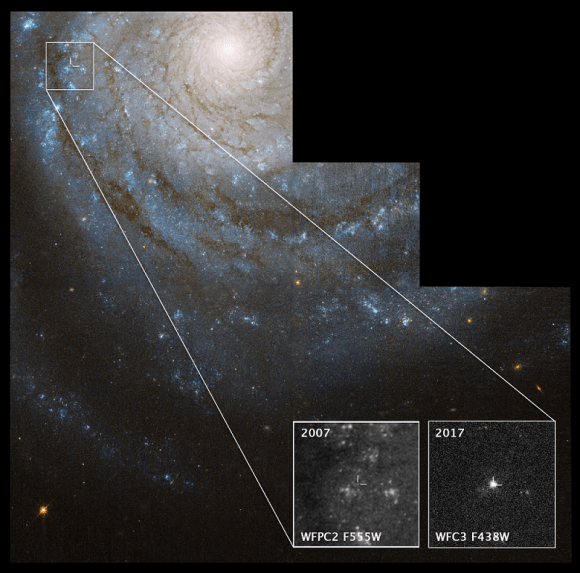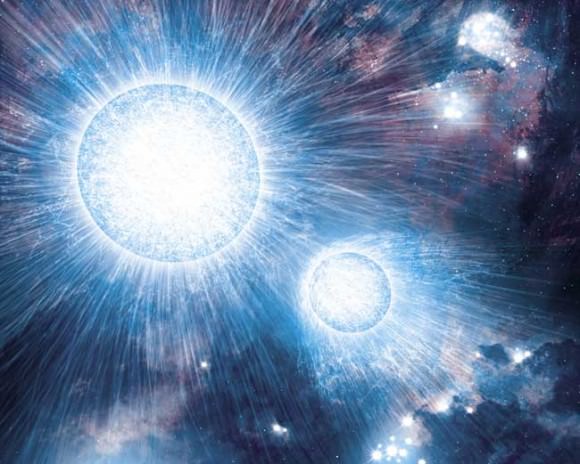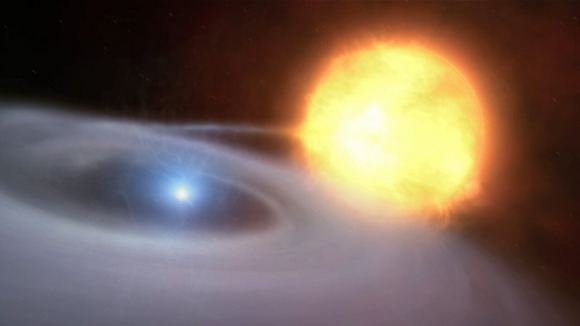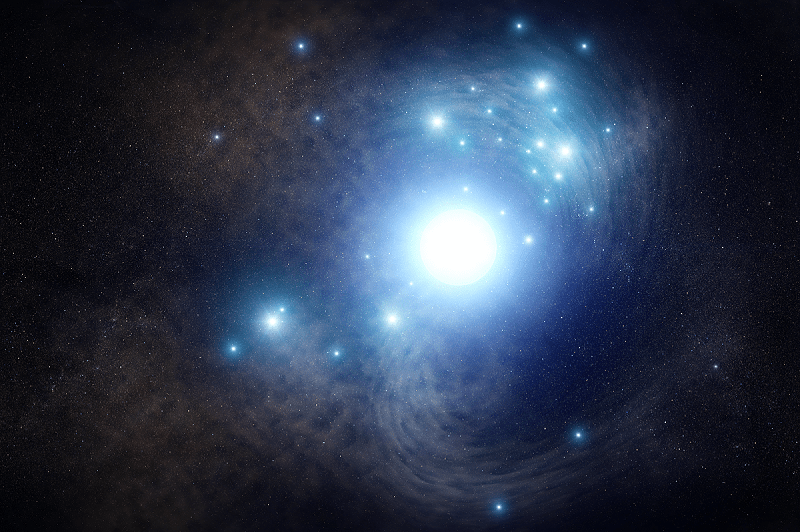As astronomical phenomena go, supernovae are among the most fascinating and spectacular. This process occurs when certain types of stars reach the end of their lifespan, where they explode and throw off their outer layers. Thanks to generations of study, astronomers have been able to classify most observed supernovae into one of two categories (Type I and Type II) and determine which kinds of stars are the progenitors for each.
However, to date, astronomers have been unable to determine which type of star eventually leads to a Type Ic supernova – a special of class where a star undergoes core collapse after being stripped of its hydrogen and helium. But thanks to the efforts of two teams of astronomers that pored over archival data from the Hubble Space Telescope, scientists have now found the long sought-after star that causes this type of supernova.
Basically, Type I supernovae are thought to result from binary systems consisting of a white dwarf and a companion star orbiting closely together. Over time, the white dwarf will begin to siphon material from the companion until a critical mass is reached. The overpacked white dwarf then experiences core collapse and explodes in an incredibly bright outburst of material and energy.
In the case of Type Ic supernovae, which account for about 20% of massive stars that explode from core collapse, the star has lost its outer layer of hydrogen and most of its helium. These stars are believed to be among the most massive known – with at least 30 Solar masses – and remain bright even after shedding their outer layers. It has therefore been a mystery why astronomers have not been able to spot one before it went supernova.
Luckily, in 2017, a Type Ic supernova was observed taking place inside a cluster of young stars in the spiral galaxy NGC 3938, located roughly 65 million light-years away. The initial discovery was made by astronomers at the Tenagra Observatories in Arizona, but the two teams of astronomers turned to Hubble to pinpoint the exact location of the source.
The first team, led by Schuyler D. Van Dyk – a senior research scientists at Caltech’s Infrared Processing and Analysis Center (IPAC) – imaged the young supernova in June 2017 with Hubble’s Wide Field Camera 3 (WFC 3). They then used this image to locate the candidate progenitor in archival Hubble photos that were taken of NGC 3938 in December of 2007.
The second team, led by Charles Kilpatrick of the University of California Santa Cruz, observed the supernova in June 2017 in infrared images using one of the 10 m telescopes at the W.M. Keck Observatory in Hawaii. The team then analyzed the same archival Hubble photos as Van Dyk’s team to uncover the possible source.

Both teams published studies that indicated that the progenitor was a likely a blue supergiant located in one of NGC 3938’s spiral arms. As Van Dyk indicated in a recent NASA press release, “Finding a bona fide progenitor of a supernova Ic is a big prize of progenitor searching. We now have for the first time a clearly detected candidate object.”
The fact that the supernova (designated SN 2017ein) was detected in the first place was also quite fortunate, as Kilpatrick explained:
“We were fortunate that the supernova was nearby and very bright, about 5 to 10 times brighter than other Type Ic supernovas, which may have made the progenitor easier to find. Astronomers have observed many Type Ic supernovas, but they are all too far away for Hubble to resolve. You need one of these massive, bright stars in a nearby galaxy to go off. It looks like most Type Ic supernovas are less massive and therefore less bright, and that’s the reason we haven’t been able to find them.”
Based on their assessment of the progenitor, both teams offered two possibilities for the source’s identity. On the one hand, they suggested that it could be a single hefty star of between 45 and 55 Solar masses that burned very bright and hot, causing it to burn off its outer layers of hydrogen and helium before undergoing gravitational collapse.

A second possibility was that the progenitor was a massive binary system that was made up of a star that was between 60 and 80 Solar masses and a companion that was 48 Solar masses. In this scenario, the more massive star was stripped of its hydrogen and helium layers by its companion before it exploded as a supernova.
The second possibility was a bit of a surprise, since it is not what astronomers expect based on current models. When it comes to Type I supernovae, astronomers expect the binary systems to be made up of lower-mass stars, typically a neutron star with a companion that has left its main sequence and expanded to become a red giant.
The discovery of this progenitor has therefore resolves something a mystery for astronomers. For some time, they have known that Type Ic supernovae were deficient in hydrogen and helium and were not sure why. One possible explanation was that they were stripped by strong winds of charged particles. But no evidence of this has ever been found.
The other possibility involved close-orbiting binary pairs where one star was stripped of its outer layers before it exploded. But in this case, they found that the star that was stripped of material was still massive enough that it eventually exploded as a Type Ic supernova.

As Ori Fox, a researcher with the Space Telescope Science Institute (STSI) in Baltimore and a member of Van Dyk’s team, explained:
“Disentangling these two scenarios for producing Type Ic supernovas impacts our understanding of stellar evolution and star formation, including how the masses of stars are distributed when they are born, and how many stars form in interacting binary systems. And those are questions that not just astronomers studying supernovas want to know, but all astronomers are after.”
The two teams also indicated that they won’t be able to confirm the identity of the progenitor star until the supernova fades in about two years. At this time, they hope to use NASA’s James Webb Space Telescope (JWST), which is scheduled to launch in 2021, to see whether the progenitor is still very bright (as expected) and make more accurate measurements of its brightness and mass.
This latest discovery not only fills in some of the holes in our knowledge about how some stars behave when they reach the end of their main sequence phase, it also provides astronomers with an opportunity to learn more about the formation and evolution of stars in our Universe. When next-generation telescopes become available in the coming years, astronomers hope to gain vital insights into these questions.
The study led by Van Dyk, titled “SN 2017ein and the Possible First Identification of a Type Ic Supernova Progenitor” appeared in The Astrophysical Journal in June. The second study, “A potential progenitor for the Type Ic supernova 2017ein“, appeared in the Monthly Notices of the Royal Astronomical Society this past October.
Further Reading: NASA, The Astrophysical Journal, MNRAS

